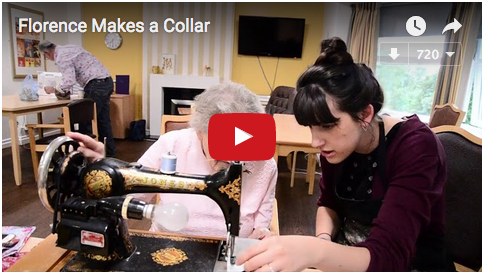Florence, who is 96 used to work in a cotton mill in Chadderton, near
Oldham. She insists she can't sew any more but when Claire found a
Victorian sewing machine in the reminiscence room, Flo just sat down and
started to make the collar that Richard had pinned. Florence repeats
certain details from her life over and over, but she is happy. It is
interesting as you sort of forget she has Dementia as the stories are so
lucid and she isn't distressed. She doesn't really know why she isn't
at home, and does worry occasionally about that. She also doesn't
remember details in the recent past - most things drift after maybe a
few minutes. It is hard to know what to say when she asks who made that,
or who has sewn that on? Sometimes if you say, it was you Flo! You can
see in her face that she is surprised and momentarily confused; 'did I?'
Rather than dwell on who made it, we tend to just move on to whether we
think it is interesting or not, and shall we make (another) one? She
enjoys making things and later on she enjoys looking at the work.
https://youtu.be/HsrKzHEctEQ
There are so many critical issues and events in a single day in a care home that it is easy to feel that 'art' and being creative is insignificant - even that it gets in the way. The first few days we were here, we definitely felt unsure about what we were doing, and did feel extraneous. So it has helped to have a couple of questions written on the wall, and just run them over everything we do. 'How does living in a care home environment affect our practice?' and 'What are the new ways of working that we are developing from being immersed in this environment?'
For three evenings this week, artist Richard Bliss has come to join us for a few hours and has been working on his piece, 'Quest For a Perfect Shirt' (read here on Richard's blog about his 'Moving In' experience). Richard's project concept is to sit in various locations (bars, cafes, trains, bus-stops and this care home) and hand sew a shirt. The activity attracts attention and conversations start. These conversations help decide the design of the next shirt.
We wanted to invite other artists into Northbourne on the simple premise that they work alongside and in the same space as the residents. It is extremely hard to see people just sitting in a chair staring at the wall, and artists always need and want spaces to work in, to allow those spaces and the people that occupy or drift through them to influence or resonate with the work. The simple act of inviting them into a lounge or dining room of a care home, not to 'entertain' or even attempt to 'engage' anyone, for us is an exciting one. It's a mutually beneficial situation that feels relaxed and alive with the potential for genuine, spontaneous human interaction and reciprocity.
